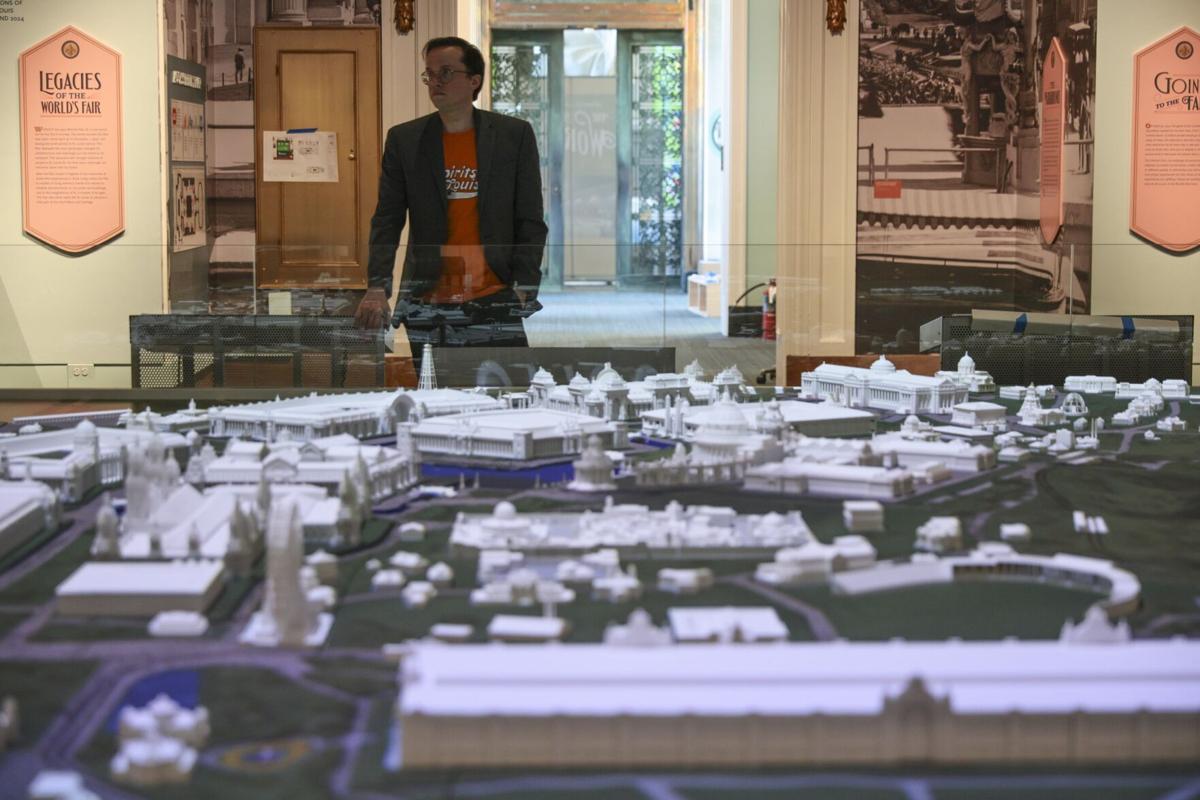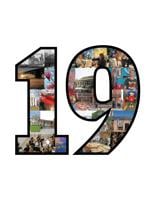Nineteen million, six hundred ninety-four thousand, eight hundred and fifty-three people passed through the gates of the Louisiana Purchase Exposition from April 30 through Dec. 1, 1904.
It has been 120 years since the 1904 WorldŌĆÖs Fair placed ║³└Ļ╩ėŲĄ at the center of the worldŌĆÖs spotlight, and the fair still remains one of the regionŌĆÖs favorite topics.
For 20 years, the Missouri History Museum has featured a popular exhibit about the fair. Last April, it closed for some much-needed renovations, rethinking and sprucing up.
The exhibit ŌĆö or rather, a new version of it ŌĆö reopens on April 27.
The centerpiece, literally as well as figuratively, is a an expansive 1:400 scale model of the fairgrounds. The aspirational, built-to-impress Beaux Arts-style buildings were rendered by local design firm PGAV Destinations using 3D printing.
People are also reading…
Periodically, an image of what the fairgrounds look like now is projected on top of the model, giving visitors both an understanding of its size and where everything was located.

Adam Kloppe, public historian at the Missouri History Museum, talks about artwork on display by local Filipina artist Ria Unson whose great-grandfather worked at the Philippine Village as a waiter and guide during the 1904 World's Fair at the event's new exhibit at the Missouri History Museum in Forest Park in ║³└Ļ╩ėŲĄ on Thursday, March 21, 2024.
Photo by Vanessa Abbitt, vabbitt@post-dispatch.com
Many of the buildings were of massive proportions, and several were of unusual shape ŌĆö the Texas Building was in the shape of a star. The Ferris Wheel ŌĆö the first one ever built, though the fair was its second and final location ŌĆö stood an almost unfathomable 264 feet high. At a horseshoe-shaped pavilion, veterans from both sides of the Boer Wars reenacted battles they had fought.
The wars, which were fought over British control of South Africa, had only ended two years before, and genuine hard feelings were still felt by combatants on both sides. Still, the attraction was so popular that it toured the United States after the fair ended, said Jody Sowell, president and CEO of the Missouri Historical Society.

A scale model of model of the 1904 World's Fair is illustrated with light at the Missouri History Museum in Forest Park in ║³└Ļ╩ėŲĄ on Thursday, March 21, 2024. Photo by Vanessa Abbitt, vabbitt@post-dispatch.com
Along one edge of the fair, just north of what is now Lindell Boulevard, was the Pike, a mile-long stretch of restaurants and amusements similar to a carnival midway. There is where hungry fairgoers could find a Tyrolean Alps restaurant in front of what, if contemporary photographs are to be believed, was a remarkably realistic reproduction of snow-topped mountains.
On the Pike, too, were found such attractions as elephants going down slides and a horse, Beautiful Jim Key, who could (or at least appeared to) spell words and solve mathematical equations, Sowell said.
Few of the fairŌĆÖs 1,500 buildings are still standing today. The Palace of Fine Arts, which now houses the ║³└Ļ╩ėŲĄ Art Museum, was almost hidden behind Festival Hall atop what is now Art Hill, overlooking the Grand Basin. The birdcage at the ║³└Ļ╩ėŲĄ Zoo was also built for the fair.
A few buildings still stand on the campus of Washington University that were leased to the fair while the school was in the process of moving from downtown to its current location, Sowell said, including Brookings Hall.

Jody Sowell, president and CEO of the Missouri Historical Society, stands on a balcony overlooking a scale model of the 1904 World's Fair behind large prints of archival photos from the event at the Missouri History Museum.
The rest of the buildings, for all of their grandiose design, were built to be destroyed. They were created out of staff, a temporary building material made chiefly from plaster of Paris, plus other ingredients, that can be easily molded, shaped and nailed. The exhibit includes a couple of the fairŌĆÖs ornamental architectural details made of staff, including a lionŌĆÖs head.
Another display sure to get a lot of attention is a screen showing selected clips from the 1944 MGM classic ŌĆ£Meet Me in ║³└Ļ╩ėŲĄ.ŌĆØ For a limited time at Christmas, the exhibit will also feature the red dress and beaded and sequined scarf Judy Garland wore in the film when she introduced the song ŌĆ£Have Yourself a Merry Little Christmas.ŌĆØ
Part of the exhibit is devoted to the actual construction of the fair, including the desk David Francis used when he pushed for the fair to become a reality. Next to it is the shovel used for the 1902 groundbreaking, with some of the original dirt still stuck to it.
Another display gives a sense of what could not be included among the exhibitŌĆÖs 200 artifacts. A video shows museum personnel uncrating a glass container of preserved pears and preserved tomatoes that were shown at the fair. They are still well preserved, but their skins have become too fragile to be handled, Sowell said.

Jody Sowell, president and CEO of the Missouri Historical Society, gestures toward a digital image of jars of preserved pears and tomatoes from 120 years ago in a display about the 1904 World's Fair at the Missouri History Museum, stands behind a scale model of the 1904 World's Fair at the museum in Forest Park in ║³└Ļ╩ėŲĄ on Thursday, March 21, 2024.
Photo by Vanessa Abbitt, vabbitt@post-dispatch.com
The bizarre story of the marathon race in the 1904 Olympics, held in ║³└Ļ╩ėŲĄ in conjunction with the fair, has been retained in the new exhibit. On a brutally hot day that kept many of the runners from finishing, Fred Lorz crossed the finish line first ŌĆö but only because he had ridden 10 miles in a car.
The second-place finisher, Thomas Hicks, was named the winner. He had tried to keep up his energy during the race by drinking brandy and strychnine, and was so overcome by heat and fatigue that he was hallucinating as he crossed the finish line.
Nine miles out, runner Fred Lorz of New York's Mohawk Athletic Club got cramps in the oppressive 90-degree heat and hitched a ride in a car.
Sixty-two countries had buildings at the fair showcasing their art, culture and industry, and so did 43 of the nationŌĆÖs then-45 states. As the host state, Missouri wanted to show something extraordinary, so it kept its building at a temperate 70 degrees through air conditioning. It was the first publicly accessible air-conditioned building in America.
Less than two weeks before the fair ended, it burned to the ground ŌĆö not because of the air conditioning, Sowell said.
A smaller exhibition space in the back will be for temporary exhibits that will only stay for two years, said Adam Kloppe, the museumŌĆÖs public historian. The opening exhibit in that area will focus on the world in 1904 and will include a collection of ruby-glass souvenirs, most of them personalized, that were among the most popular items at the fair.
The exhibit is notable for its inclusion of stories of some of the people who were overlooked in the earlier exhibit. Touchscreen displays along the scale model discuss the treatment of Blacks and Filipinos, and shows the relevant locations on the model.
ŌĆ£WeŌĆÖre hoping that the exhibit will help people realize the wonders of the 1904 WorldŌĆÖs Fair, but also realize the complexity,ŌĆØ Sowell said.
Nearly 200,000 people were on hand on opening day, and the 1904 World's Fair in ║³└Ļ╩ėŲĄ went on to become a smashing success.
















